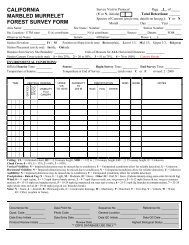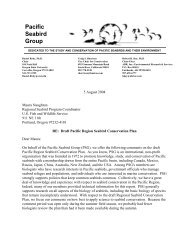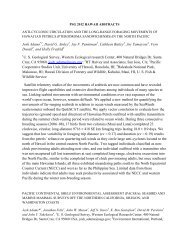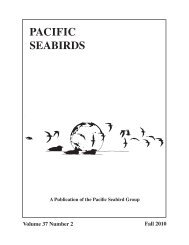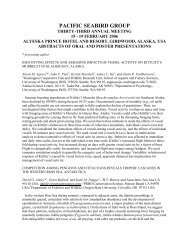abstracts of oral and poster presentations - Pacific Seabird Group
abstracts of oral and poster presentations - Pacific Seabird Group
abstracts of oral and poster presentations - Pacific Seabird Group
Create successful ePaper yourself
Turn your PDF publications into a flip-book with our unique Google optimized e-Paper software.
local population trends with relatively modest effort. Radar counts are insufficient to show current trends but<br />
are suggested for future monitoring <strong>and</strong> management <strong>of</strong> murrelets in BC.<br />
CONSERVATION ISSUES OF THE XANTUS'S MURRELET IN CALIFORNIA<br />
Esther E. Burkett (EBurkett@dfg.ca.gov); California Department <strong>of</strong> Fish <strong>and</strong> Game, Sacramento, CA USA<br />
On 16 April 2002, the California Fish <strong>and</strong> Game Commission (Commission) received a petition to list<br />
the Xantus's Murrelet (Synthliboramphus hypoleucus) as a threatened species under the California Endangered<br />
Species Act (CESA); the <strong>Pacific</strong> <strong>Seabird</strong> <strong>Group</strong> (PSG) submitted the petition. In response to the petition, the<br />
Department <strong>of</strong> Fish <strong>and</strong> Game (Department) produced a status report on the murrelet in November 2003, <strong>and</strong> the<br />
Commission subsequently approved state-listing <strong>of</strong> the species. The Department recommended listing <strong>of</strong> the<br />
murrelet as threatened due to: (1) small breeding population size in California; (2) documented population<br />
decline <strong>of</strong> approximately 30% from 1977 to 1991 on Santa Barbara Isl<strong>and</strong>; (3) declining occupancy rates at<br />
nesting sites on Santa Barbara Isl<strong>and</strong>; (4) near extirpation from previously known nesting sites, based on historic<br />
<strong>and</strong> current scientific information; (5) vulnerability to oil spills during the breeding <strong>and</strong> non-breeding season; (6)<br />
suppression <strong>of</strong> population growth by a variety <strong>of</strong> native <strong>and</strong> non-native predators; <strong>and</strong> (7) impacts from artificial<br />
light pollution <strong>and</strong> human disturbance activities. Monitoring programs need to be evaluated, <strong>and</strong> predation<br />
impacts need further study. The status review recommended interagency coordination with the goal <strong>of</strong> stopping,<br />
<strong>and</strong> then reversing, the population decline <strong>of</strong> the murrelet. An interagency team, including PSG, should be<br />
developed to prioritize management recommendations <strong>and</strong> assure conservation <strong>of</strong> the murrelet.<br />
DISTRIBUTION, ABUNDANCE AND REPRODUCTION OF SEABIRDS AT GORGONA ISLAND,<br />
COLOMBIA<br />
Giannina Cadena-Lopez* 1 (gianni_cadena@hotmail.com) <strong>and</strong> Luis G. Naranjo 2 ; 1 Departamento de Biología,<br />
Universidad del Valle <strong>and</strong> Asociación Calidris, Cali COLOMBIA; 2 World Wildlife Fund, Cali COLOMBIA<br />
Throughout 2003, we carried out visual censuses <strong>of</strong> pelecaniform birds at Gorgona Isl<strong>and</strong> National<br />
Natural Park, Colombia. We mapped the spatial distribution, estimated population densities, <strong>and</strong> recorded the<br />
reproduction <strong>of</strong> Pelecanus occidentalis, Sula nebouxii, Sula leucogaster, <strong>and</strong> Fregata magnificens. We<br />
estimated a total <strong>of</strong> 20,000 seabirds on the isl<strong>and</strong>. The most abundant species was S. nebouxii, with almost<br />
13,000 birds, <strong>and</strong> the least abundant was S. leucogaster, with 300. Between February <strong>and</strong> August, we observed<br />
the simultaneous breeding <strong>of</strong> 800–1,000 pairs <strong>of</strong> P. occidentalis. Around 100 pairs <strong>of</strong> S. leucogaster bred<br />
during the year, with a concentration <strong>of</strong> the reproductive effort between July <strong>and</strong> September. We did not record<br />
breeding <strong>of</strong> S. nebouxii or F. magnificens, although we observed some courtship behavior <strong>of</strong> the latter.<br />
Explanation <strong>of</strong> the temp<strong>oral</strong> variation <strong>of</strong> the populations <strong>of</strong> seabirds requires more detailed information about<br />
diet <strong>and</strong> distribution <strong>and</strong> availability <strong>of</strong> food during the year. This work marks the beginning <strong>of</strong> a st<strong>and</strong>ardized,<br />
long-term monitoring program <strong>of</strong> seabird populations in Colombia.<br />
IS CLIMATE CHANGE ALTERING THE BREEDING PHENOLOGY OF THE ENDANGERED GREAT<br />
LAKES PIPING PLOVER POPULATION<br />
Amelia K. Canavan* 1 (cana0022@umn.edu) <strong>and</strong> Francesca J. Cuthbert 2 ; 1 Conservation Biology Graduate<br />
Program, University <strong>of</strong> Minnesota, St. Paul, MN USA; 2 Department <strong>of</strong> Fisheries, Wildlife & Conservation<br />
Biology, University <strong>of</strong> Minnesota, St. Paul, MN USA<br />
The current global warming paradigm predicts new impacts on ecosystems <strong>and</strong> the organisms that<br />
inhabit them. In the Great Lakes region, climate change will likely alter temperature trends, seasonality, <strong>and</strong><br />
water levels. The Great Lakes Piping Plover population breeds in shoreline habitat that is sensitive to climateinduced<br />
events. The purpose <strong>of</strong> this study was to analyze a 10-year database on breeding phenology to<br />
determine if plovers are responding to regional climate fluctuations. The Piping Plover appears to be nesting<br />
earlier, with year alone as a statistically significant indicator. We also examined correlations between May daily<br />
low temperatures <strong>and</strong> nest-initiation dates. It appears that earlier mean nest initiation correlates with fewer days<br />
in May with temperatures falling below 45°F. Also examined were correlations between precipitation <strong>and</strong><br />
reproductive success <strong>and</strong> correlations between lake levels <strong>and</strong> reproductive success. These correlations are less<br />
clear but may become more important with future changes in amount <strong>of</strong> lake level fluctuation, overall water-



